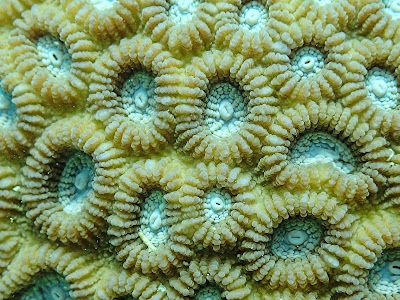Crown-of-thorns removal mission!
 |
| A Crown-of-Thorns starfish (Acanthaster planci) |
The crown-of-thorns (Acanthaster planci), is a large, thorned starfish which lives along
the shallow reefs of the tropical band of the globe. It has all the fundamental
components of any other starfish - a central disk, perimeter by radiating arms -
but unlike most, this starfish can have up to 23, regenerative arms (all of
which can be replaced in the case of lost limbs) covered with long poisonous spines. Usually found ranging between
25 cm – 35 cm in its adult stage, some individuals can be as large as 80 cm. The
crown-of-thorns is a carnivorous predator, feeding on live coral tissue by
everting its stomach over their surfaces. As well as hard corals, they can also
feed on soft corals, sponges and encrusting organisms. Their presence on a reef
give slower growing coral communities (e.g. Favites) an opportunity to flourish by preferring feeding
on branching and plate fast growing corals (e.g. Acropora) However, the large size of the starfish and its
propensity of spectacular population outbreaks can result in massive coral
mortality. The Seychelles experienced their last outbreak in 2014 on the
Northwest coast of Mahé. The main hypothesis
for population outbreaks are nutrient enrichment that might increase the
availability of food source for the larvae and the removal of their natural
predators such as the triton shell (Charonia tritonis), some Pufferfish (Tetraodontidae),
Triggerfish (Balistidae) as the Titan Triggerfish (Balistoides
viridescens) and
the humbhead wrasse (Cheilinus undulatus).
 |
| A starfish arm covered with long poisonous spines |
 |
| Some of the collected crown-of-thorns |
Following major disturbances such as a bleaching
event, reefs are in the process of recovery. The heavy presence of those
voracious predators might negatively affect the reef recovery trajectory as they
feed on the newly settled coral colonies. The Fisherman’s Cove reef is under
both global threats, resulting from the climate change such as increasing sea
water temperatures leading to coral bleaching, and local threats such as
physical human damages.
To promote the natural recruitment and
hence the recovery of the Fisherman’s Cove reef, the MCSS Coral Cove team has
decided to remove the excess of crown-of-thorns starfish from the reef.
Eighteen individuals were taken out from the reef the same day in just two trips along the snorkelling
trail. The team will keep watching the reef for any overabundance of these
coral predators.
Watch the video of our Crown-of-thorns removal mission by Carolyn Cowan, one of volunteer!


This comment has been removed by the author.
ReplyDelete